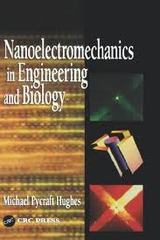
Nanoelectromechanics in Engineering and Biology
Michael Pycraft Hughes
(2002) 300 pages
The author delivers a wealth of application and background knowledge, from using electric fields for particle sorting in lab-on-a-chip devices to electrode fabrication, electric field simulation, and computer analysis. It also explores how electromechanics can be applied to sorting DNA molecules, examining viruses, constructing electronic devices with carbon nanotubes, and actuating nanoscale electric motors.
The field of nanotechnology is inherently multidisciplinary-in its principles, in its techniques, and in its applications-and meeting its current and future challenges will require the kind of approach reflected in this book. Unmatched in its scope, Nanoelectromechanics in Engineering and Biology offers an outstanding opportunity for people in all areas of research and technology to explore the use and precise manipulation of nanoscale structures.
"Dr. Hughes' book… is unique in bridging the gap between key disciplines critical to the future of nanotechnology in the 21st century. The boundaries between disciplines are fast disappearing, but few textbooks have captured the need for providing students with a spectrum of information across the key areas of science and technology where it is predicted many new developments will take place. This is at the critical interface between nanoscience, mechanical and electrical/electronic engineering and biology. The many academic institutions that are in the process of setting up truly multidisciplinary departments and research groups will find this timely publication neatly fills what was until now a worrying vacuum."
-Ottilia Saxl, CEO, The Institute of Nanotechnology
Contents
INTRODUCTION
Movement from Electricity; The Promise of Nanotechnology; Electrodynamics; Electrokinetics and Nanoparticles; A Note on Terminology
ELECTROKINETICS
The Laws of Electrostatics; Coulomb's Law, Electric Field and Electrostatic Potential; Gauss', Laplace's and Poisson's Equations; Conductance and Capacitance; Polarization and Dispersion; Dielectric Spheres in Electric Fields; Forces in Field Gradients
Dielectrophoresis and Electrorotation
COLLOIDS AND SURFACES
Colloids; The Electrical Double Layer; The Gouy-Chapman Model; The Stern Layer; Particles in Moving Fluids; Colloids in Electric Fields; Electrode Polarization and Fluid Flow; Other Forces Affecting Colloidal Particles
ANALYSIS AND MANIPULATION OF SOLID PARTICLES
Dielectrophoresis of Homogeneous Colloids; Frequency-Dependent Behavior and the Crossover Frequency; Double Layer Effects; Dielectrophoresis vs. Fluid Flow; Separating Spheres; Trapping Single Particles; Limitations on Minimum Particle Trapping Size; Dielectrophoresis and Laser Trapping
DIELECTROPHORESIS OF COMPLEX BIOPARTICLES
Manipulating Viruses; Anatomy of Viruses; The Multi-Shell Model; Methods of Measuring Dielectrophoretic Response; Examining Virus Structure by Dielectrophoresis; The Interpretation of Crossover Data; Studying Non-Spherical Viruses; Separating Viruses; Unexpected Charge Effects
DIELECTROPHORESIS, MOLECULES AND MATERIALS
Manipulation at the Molecular Scale; Manipulating Proteins; Dielectrophoresis for Protein Analysis; DNA; Dielectrophoretic Manipulation of DNA; Applications of DNA Manipulation; Nanotubes, Nanowires and Carbon-60
NANOENGINEERING
Towards Molecular Nanotechnology; Directed Self Assembly; Device Assembly; Electrostatic Self-Assembly; Electronics with Nanotubes, Nanowires and Carbon-60; Putting it all Together
The Potential for Dielectrophoretic Nanoassembly; Dielectrophoresis and Materials Science; Nanoelectromechanical Systems
PRACTICAL DIELECTROPHORETIC SEPARATION
Limitations on Dielectrophoretic Separation; Flow Separation; Field Flow Fractionation; Thermal Ratchets; Separation Strategies using Dielectrophoretic Ratchets; Stacked Ratcheting Mechanisms; Traveling Wave Dielectrophoresis; Applications of Traveling Wave Dielectrophoresis
ELECTRODE STRUCTURES
Microengineering; Electrode Fabrication Techniques; Laboratories on a Chip; A Note about Patents
COMPUTATIONAL APPLICATIONS IN ELECTROMECHANICS
The Need for Simulation; Principles of Electric Field Simulation; Analytical Methods; Numerical Methods; Finite Element Analysis; The Method of Moments; Commercial vs. Custom Software; Determination of Dynamic Field Effects; Example
Simulation of Polynomial Electrodes
DIELECTROPHORETIC RESPONSE MODELING AND MATLAB
- Modeling the Dielectrophoretic Response; Programming in MATLAB; Modeling the CLAUSIUS-MOSSOTTI FACTOR; Determining the Crossover Spectrum; Modeling Surface Conductance Effects; Multi-Shell Objects; Finding the Best Fit; MATLAB in Time-Variant Field Analysis; Other MATLAB Functions
APPENDIX A. A DIELECTROPHORETIC ROTARY NANOMOTOR
A PROPOSAL
Contact us at info@electrostatic.com
 Electrostatic Applications
Electrostatic Applications